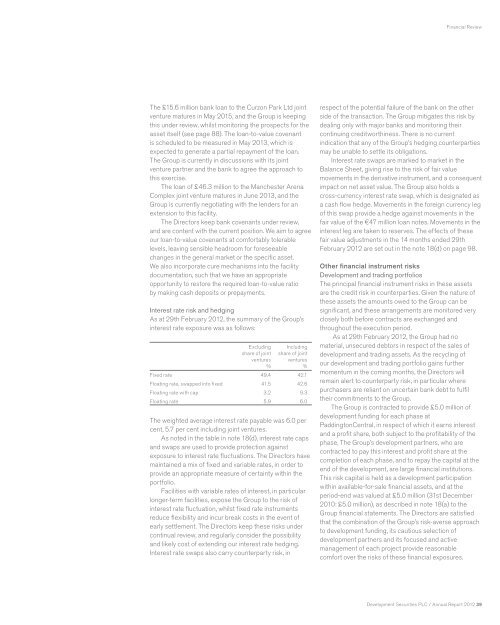Annual Report 2012 - Development Securities PLC
Annual Report 2012 - Development Securities PLC
Annual Report 2012 - Development Securities PLC
You also want an ePaper? Increase the reach of your titles
YUMPU automatically turns print PDFs into web optimized ePapers that Google loves.
The £15.6 million bank loan to the Curzon Park Ltd joint<br />
venture matures in May 2015, and the Group is keeping<br />
this under review, whilst monitoring the prospects for the<br />
asset itself (see page 88). The loan-to-value covenant<br />
is scheduled to be measured in May 2013, which is<br />
expected to generate a partial repayment of the loan.<br />
The Group is currently in discussions with its joint<br />
venture partner and the bank to agree the approach to<br />
this exercise.<br />
The loan of £46.3 million to the Manchester Arena<br />
Complex joint venture matures in June 2013, and the<br />
Group is currently negotiating with the lenders for an<br />
extension to this facility.<br />
The Directors keep bank covenants under review,<br />
and are content with the current position. We aim to agree<br />
our loan-to-value covenants at comfortably tolerable<br />
levels, leaving sensible headroom for foreseeable<br />
changes in the general market or the specific asset.<br />
We also incorporate cure mechanisms into the facility<br />
documentation, such that we have an appropriate<br />
opportunity to restore the required loan-to-value ratio<br />
by making cash deposits or prepayments.<br />
Interest rate risk and hedging<br />
As at 29th February <strong>2012</strong>, the summary of the Group’s<br />
interest rate exposure was as follows:<br />
Excluding<br />
share of joint<br />
ventures<br />
%<br />
Including<br />
share of joint<br />
ventures<br />
%<br />
Fixed rate 49.4 42.1<br />
Floating rate, swapped into fixed 41.5 42.6<br />
Floating rate with cap 3.2 9.3<br />
Floating rate 5.9 6.0<br />
The weighted average interest rate payable was 6.0 per<br />
cent, 5.7 per cent including joint ventures.<br />
As noted in the table in note 18(d), interest rate caps<br />
and swaps are used to provide protection against<br />
exposure to interest rate fluctuations. The Directors have<br />
maintained a mix of fixed and variable rates, in order to<br />
provide an appropriate measure of certainty within the<br />
portfolio.<br />
Facilities with variable rates of interest, in particular<br />
longer-term facilities, expose the Group to the risk of<br />
interest rate fluctuation, whilst fixed rate instruments<br />
reduce flexibility and incur break costs in the event of<br />
early settlement. The Directors keep these risks under<br />
continual review, and regularly consider the possibility<br />
and likely cost of extending our interest rate hedging.<br />
Interest rate swaps also carry counterparty risk, in<br />
Financial Review<br />
respect of the potential failure of the bank on the other<br />
side of the transaction. The Group mitigates this risk by<br />
dealing only with major banks and monitoring their<br />
continuing creditworthiness. There is no current<br />
indication that any of the Group’s hedging counterparties<br />
may be unable to settle its obligations.<br />
Interest rate swaps are marked to market in the<br />
Balance Sheet, giving rise to the risk of fair value<br />
movements in the derivative instrument, and a consequent<br />
impact on net asset value. The Group also holds a<br />
cross-currency interest rate swap, which is designated as<br />
a cash flow hedge. Movements in the foreign currency leg<br />
of this swap provide a hedge against movements in the<br />
fair value of the €47 million loan notes. Movements in the<br />
interest leg are taken to reserves. The effects of these<br />
fair value adjustments in the 14 months ended 29th<br />
February <strong>2012</strong> are set out in the note 18(d) on page 98.<br />
Other financial instrument risks<br />
<strong>Development</strong> and trading portfolios<br />
The principal financial instrument risks in these assets<br />
are the credit risk in counterparties. Given the nature of<br />
these assets the amounts owed to the Group can be<br />
significant, and these arrangements are monitored very<br />
closely both before contracts are exchanged and<br />
throughout the execution period.<br />
As at 29th February <strong>2012</strong>, the Group had no<br />
material, unsecured debtors in respect of the sales of<br />
development and trading assets. As the recycling of<br />
our development and trading portfolio gains further<br />
momentum in the coming months, the Directors will<br />
remain alert to counterparty risk, in particular where<br />
purchasers are reliant on uncertain bank debt to fulfil<br />
their commitments to the Group.<br />
The Group is contracted to provide £5.0 million of<br />
development funding for each phase at<br />
PaddingtonCentral, in respect of which it earns interest<br />
and a profit share, both subject to the profitability of the<br />
phase. The Group’s development partners, who are<br />
contracted to pay this interest and profit share at the<br />
completion of each phase, and to repay the capital at the<br />
end of the development, are large financial institutions.<br />
This risk capital is held as a development participation<br />
within available-for-sale financial assets, and at the<br />
period-end was valued at £5.0 million (31st December<br />
2010: £5.0 million), as described in note 18(a) to the<br />
Group financial statements. The Directors are satisfied<br />
that the combination of the Group’s risk-averse approach<br />
to development funding, its cautious selection of<br />
development partners and its focused and active<br />
management of each project provide reasonable<br />
comfort over the risks of these financial exposures.<br />
<strong>Development</strong> <strong>Securities</strong> <strong>PLC</strong> / <strong>Annual</strong> <strong>Report</strong> <strong>2012</strong> 39






